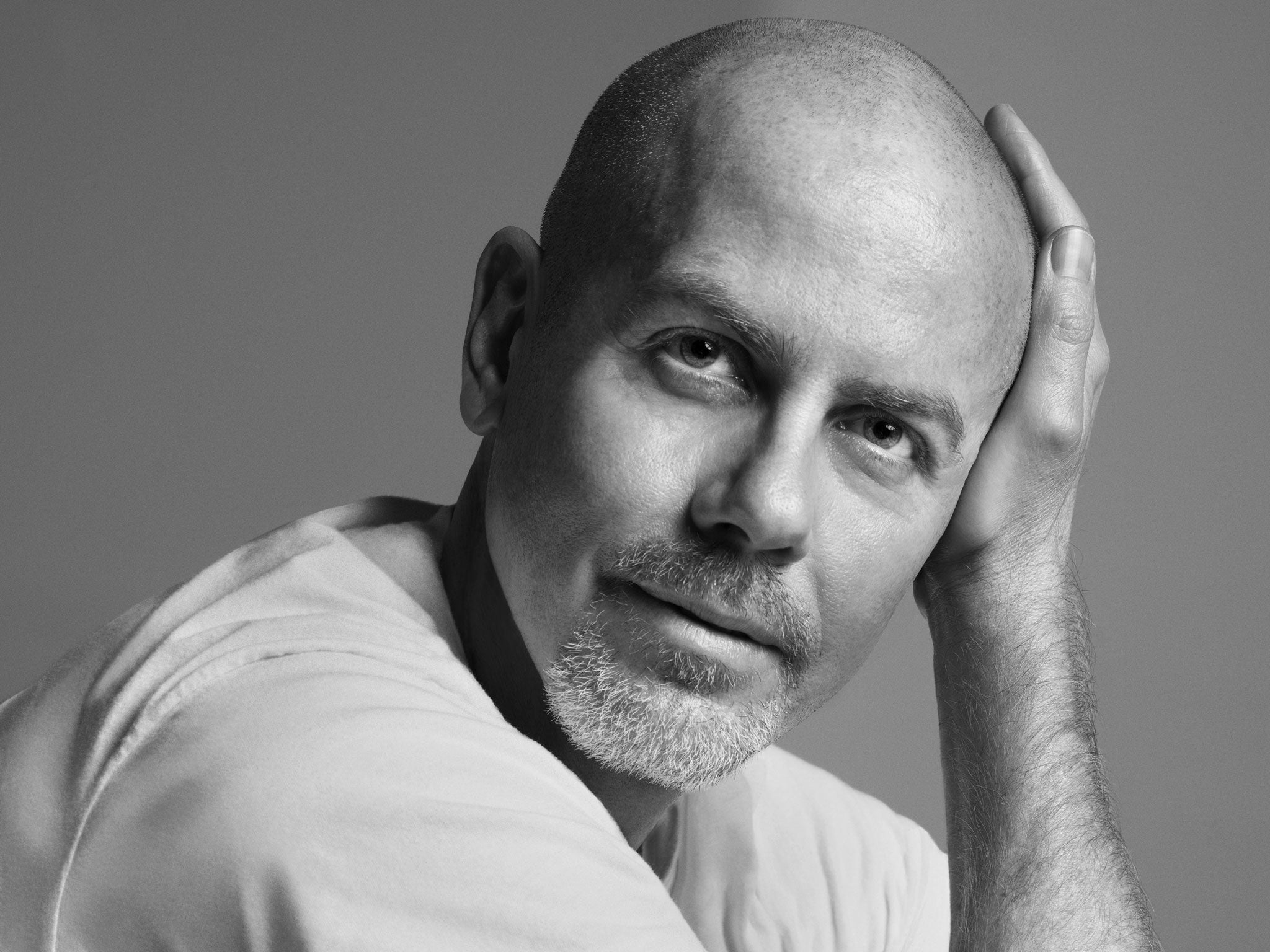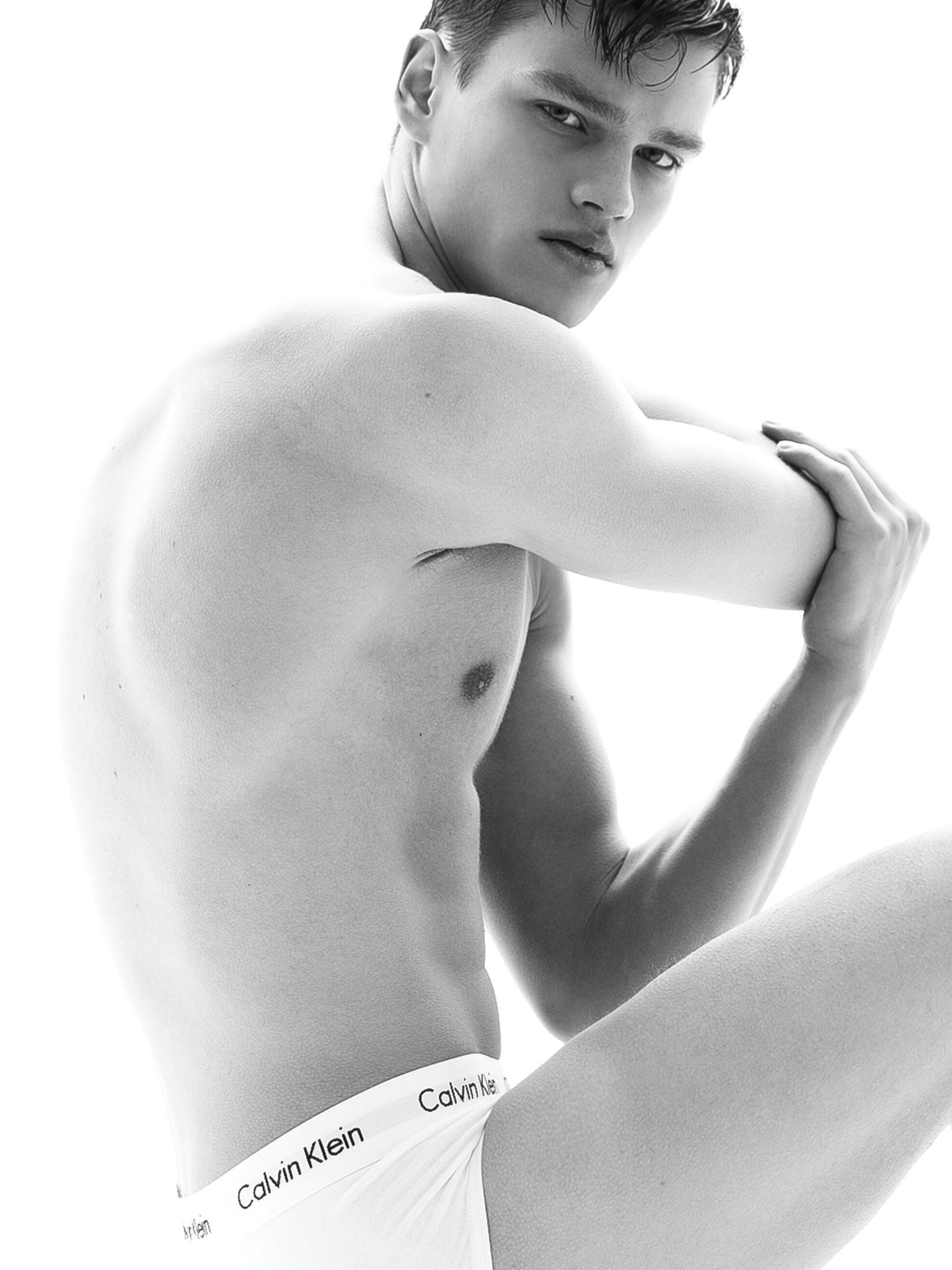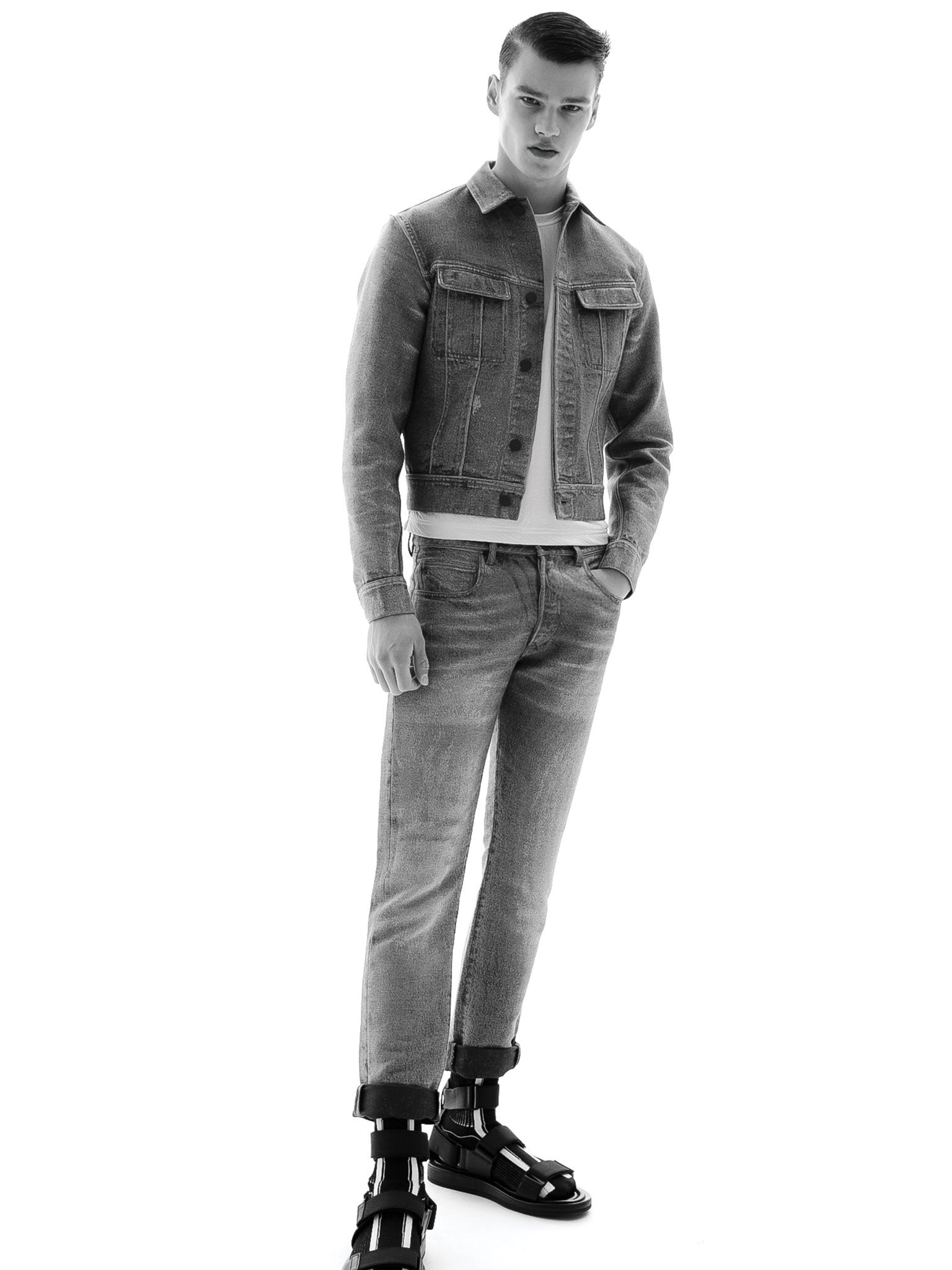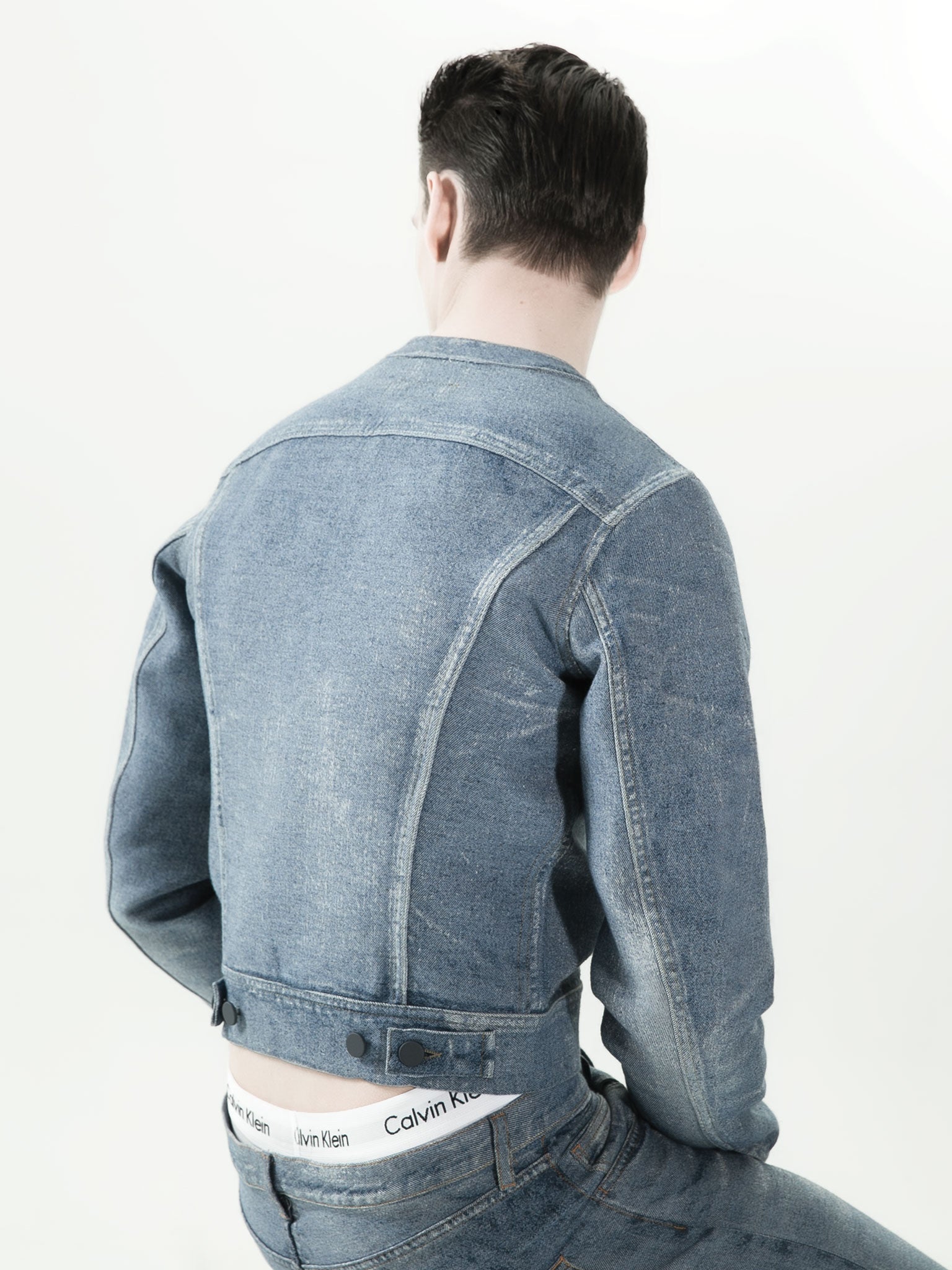Calvin Klein redefined American masculinity, but Italian Italo Zucchelli has brought it bang up to date
Calvin Klein embodies an ideal of American manhood that enshrines both muscularity and sexuality. But it's taken an Italian creative director to keep the look fresh. Italo Zucchelli tells Alexander Fury how he does it

There's an old story that the New York base of Calvin Klein Inc. – located at 205 West 39th Street, just off Seventh Avenue and all its rag-trade associations – used to be whitewashed every weekend during Mr Klein's tenure. The place, it was said, permanently stank of fresh paint. It doesn't any more. Maybe they just use a less potent mix, because the HQ seems no less pristine. Kleinland is bone-white –as white as the tighty-whitey underwear that, along with designer jeans have helped build an empire worth some $8.1bn (£5.6bn) today.
Italo Zucchelli's eyes are the same blue as his Calvins. That sounds like a line from a bad novel, or maybe from the trashy 1995 Klein biography Obsession: The Lives and Times of Calvin Klein. It's a favourite read of mine – although to be taken with a pinch of salt. Zucchelli, however, doesn't design Calvin's jeans. He's the men's creative director of the Calvin Klein Collection label, which shows in Milan and is known for precise suiting, rigorous minimalism and a conceptual thought process. Clever-clogs togs. Incidentally, for spring, they did include jeans, of a sort – a jacquard, in cotton and polyester, that looks like a denim from a distance, or in a photograph, but in reality is firmer, thicker, crisper, and much more expensive. Zucchelli's jeans will set you back about £450.
Those jeans summarise the 50-year-old designer's approach to the Calvin Klein Collection brand, a moniker whose final word is rigorously asserted, to differentiate between the various Klein sub-divisions. Those include lines christened Calvin Klein platinum; Calvin Klein white label; Calvin Klein Jeans and Calvin Klein Underwear – targeting different consumers at different price levels, letting them buy into the Klein dream. Calvin Klein Collection has been dubbed the "halo brand". And hence Zucchelli is the chosen one – for menswear at least – Francisco Costa oversees the womenswear.
Calvin Klein himself is still alive, aged 73, but he's not on the scene. His company was bought for some $700m in 2003 by Phillips-Van Heusen Corporation, a conglomerate who also own American institutions like Arrow shirts and Tommy Hilfiger. Following a public display of intoxication at a Knicks game at Madison Square Gardens, Klein entered rehab at the Meadows facility in Arizona, and subsequently retired from his company. Maybe that was the plan all along, but probably not just six weeks after what proved to be his final women's ready-to-wear show. He consulted until 2006 – his was the hand and eye behind the brand's Euphoria fragrance in 2006 – but both Costa and Zucchelli were brought on board by Klein himself, essentially hand-picked to be his heirs.
There's still plenty of Calvin in the house Klein built. I meet Italo Zucchelli in those whiter-than-white CK offices, where he wears a white shirt and those jeans. I'm not sure if they're Collection or just plain Calvin, and it seems churlish to ask, as gauche as enquiring as to the price of someone's handbag.
If Klein is sometimes perceived as cold and austere (via stuff like that whitewashing rumour), Zucchelli is gregarious and forthcoming, warm and welcoming. He's Italian, born in La Spezia in the north-west of the country in 1965, and trained in Florence, first in architecture and then in fashion at Polimoda International Institute, graduating in 1988. He worked for the Milanese designer Romeo Gigli and the German Jil Sander, before joining Klein at the behest of the founder, working with him for six seasons before Klein's departure. He's done so ever since.
That history is reflected in his clothes. Zucchelli frequently pushes the architecture of his garments, creating clothes that bubble and lift around the body, forming unusual shapes and abstract effects. I once sat next to a gangly teenager on a flight from Milan, who had been modelling in Zucchelli's winter 2014 show. Via cut and those constructed fabrics, he'd been bulked-out unrecognisably – to übermensch proportions. The fabric technologies are a legacy of his time at Gigli, whose clothes had a distinctly un-Klein sense of renaissance richness. Sander, a dour Hamburg-based designer known for pioneering minimalism in the early 1990s, was a more natural fit.

Still, even Sander's strictness isn't the perfect match for Calvin Klein, with its frissons of provocation and sexuality absent from Sander's frosty (even frigid) fashion. Klein is a complex brand. It's tricky to get it right. Zucchelli's menswear toes a strange line, almost unique in contemporary menswear, Calvin Klein is a point of convergence between contemporary ideas of masculine sexuality and beauty, American cultural imperialism and clean sportswear. All ideas that have relevance to wardrobes of men across the world. Give them to a designer like Zucchelli, and you end up with some> thing unexpected and compelling. It helps that Calvin Klein, as a name, is an immediate flash-point for many. "I've met people who didn't even know there was a Calvin Klein – they thought it was just the name of a product," stated Klein. And those Klein codes – the sportswear, the jeans, the underwear, the throbbing sexuality, usually male, even down to Klein women's underwear, launched in 1984, originally being based on men's (an idea apparently inspired by his then-wife, Kelly Rector) – are rich pickings for a designer. Klein isn't really an aesthetic – a jacket, a dress – it's something more ephemeral.
"My very first recollection of this brand I was 16 or 17," says Zucchelli – shaven-headed, tanned, his Italian accent strong even after living in New York for 16 years. "It was the Bruce Weber underwear campaign. It was very new also. It was expressing an ideal of masculinity that was very, in my imagination, American. It was very clean, very athletic, very healthy-looking. That stayed with me."
It's an idea that has undoubtedly informed Zucchelli, both his own perceptions of Klein, and his subsequent projection of the label's aesthetic. Calvin Klein menswear stands out in the landscape of contemporary fashion, for its apparent simplicity, its strength, and, overwhelmingly, for an odd, twisted take on the clichés of Americana. Paradoxically, Zucchelli won the CFDA award for menswear designer in 2009, seemingly for challenging those menswear mores.
It certainly didn't stop when he was crowned with laurels. Last winter, the label offered battleship-greys, models in moulded bomber jackets and peaked caps, a hypermodern Tom Cruise in Top Gun. The season before, it was fleshy tones, as if a Californian gym-bunny's pumped-up physique had melded with his clothing, white Aertex cycle pants peeking out from under flesh-coloured track shorts. And for spring, it was sheer Americana, in blue jeans and chinos: movies and heroes.

That's a little alien to the Italian Zucchelli – but, he argues, not so much. "We all grew up, in Europe, with… we are Americanised!" He laughs, shrugs. If we weren't sitting in the Calvin Klein HQ, you'd be forgiven for mistaking the T-shirted and be-jeaned Zucchelli for a Californian handyman or a gas-station attendant from the Midwest. The American national costume is now the world's costume. "Having said that," backpedals Zucchelli, "Italy has a very strong identity as a country, as a culture. But I think it adds a different spin on what an otherwise literal vision of Americanness would be. I put in an element of fantasy-ing the Americanness. Of exaggerating it. It's not literal."
That's the interesting thing – Zucchelli's America is never straightforward, not even jeans. That denim jacquard is a great metaphor for what Zucchelli does: takes the low end, and elevates. "That's what I think my job is," he says. "But I also like to do it because I like the high and low. That's how we dress. That's modern. It's also especially part of American style. There is an unfussiness to it, and easiness to it. Especially to Calvin Klein. You don't have to think too much about it."
But Zucchelli does. He's evidently been considering Calvin Klein for years, what it represents, how to represent it, how to make those signature tropes of Calvin Klein – bog-standard branded kecks, straightforward blue jeans – work in a fashion landscape of consumers bored with designers simply slapping their name on duds. Fashion today demands more thought, more consideration. Which is what Zucchelli is good at.
He is thinking about our perceptions of Calvin Klein. "There is another element, I think," he says, after all that Yankee flag-waving. "It's a big paradox. Calvin Klein, even to an Italian, was always very American. But in a non-preppy way. Which is why I was drawn to it. I always thought it was the most European of American brands. Because of the level of sophistication. Clean lines, sober. There is a paradox going on here. Plus, as a person in general, I like easiness. Unfussiness. I don't have to stop myself from putting jewels on it! Which, as a stereotypical Italian, you might think I would do…"
He grins. There's no inner Donatella in Zucchelli, screaming to wreak havoc at CK. "Although I love her," he says enthusiastically. "It's really a second skin for me, this aesthetic. It's not an effort." What he likes are the core values of Calvin. "I like to take these two references, the underwear and the jeans, because they're part of the language of the brand," he says. Then his voice drops a bit. "And the sexiness of the brand."

Ah, sex. Sex is all-important at Calvin Klein. The designer himself was a Studio 54 wild-child: he named a perfume Obsession, syncing it with sexual desire; he encouraged Brooke Shields not to demur but to declare that nothing came between herself and her Calvins. If the notion of sex selling wasn't coined by Klein, he certainly took it to new heights.
The new heights, in the post-gay liberation and pre-Aids era of the late 1970s and early 1980s, were in male sexuality. Klein launched his underwear in 1982 with the Bruce Weber image that Zucchelli saw in his teenage years – of former Olympic pole vaulter Tom Hintnaus, shot from the ground up, his penis clearly visible through plain white briefs, and very much the centrepiece of the entire image – caused a sensation. "You had a man, in his underwear, on a billboard in 1983," states Zucchelli, still incredulous. "I didn't see because I was not in New York. But it was pretty groundbreaking. Now it's everywhere. We're used to it, we don't think about it. But then… it was the first time. There is always this element, of the masculinity, of the sexuality. Expressed in different ways. It's part of the language of Calvin Klein."
It's one that Zucchelli seems particularly keen to explore. "Definitely," he says, emphatically. "For two reasons. One because, simple as that, it's something that I think every man is in one way or another linked to. Everybody wants to look good. Everybody wants to have sex with someone that looks good. It's very primordial, very basic. And two: there has definitely always been a link between that and this brand." In other words: men want it, and it makes sense.
But Zucchelli's sexuality is never just about the body. "Kinky" is a word he uses a fair bit, with a schoolboy grin. "The controversial element that is ingrained in the language of Calvin Klein… it's very hard to achieve in a show. To just show skin – it's a little too easy." That's one of the reasons the label stands out in Milan, where beefed-up blokes in budgie-smugglers are often proposed as substitutes for actual clothing. Zucchelli is more likely to colour a garment flesh than to show it.
"To do it in the clothes - how can you do it in the clothes? But I keep it in mind when I design a collection. I'm designing the highest hand of this brand – so the language needs to be quite sophisticated. What I do needs to have a sophistication to it. It's a balancing game."
If Italo Zucchelli is walking a tightrope at Calvin Klein Collection, he's doing it masterfully.
Photography: Ignazio Lozano
Model: Filip Hrivnak at Premier Model Management
Stylist: Eus Cantó
Makeup & hair: Carolina Guzman at Kasteel Agent using Moroccan oil and Nars
Stylist assistant: Eudald Fabrés
Art Direction: Borja Vilas
Join our commenting forum
Join thought-provoking conversations, follow other Independent readers and see their replies
Comments